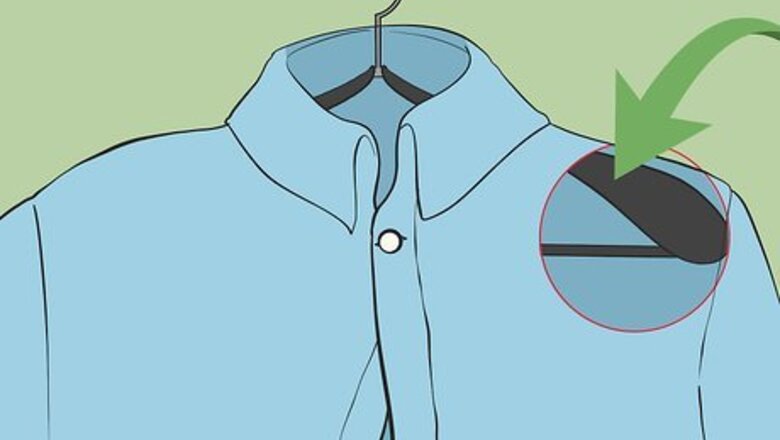
views
Preparing the Shirt and Steamer
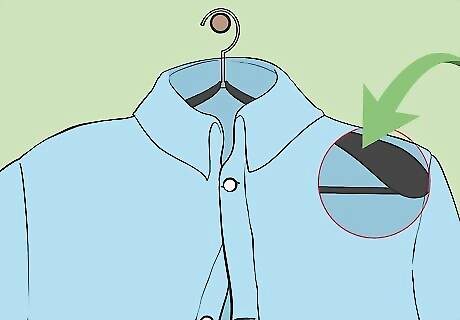
Place the shirt on a clothes hanger. You can use a flocked hanger to prevent the shirt from sliding around, but a plastic hanger will work fine as well. Close up the top button of the shirt to prevent it from slipping off the hanger. If you’re steaming a blouse or shirt without buttons, just pop it on a hanger. If there are any closures on the garment, such as a button at the center-back of a blouse neckline, close these up to keep the garment in place.
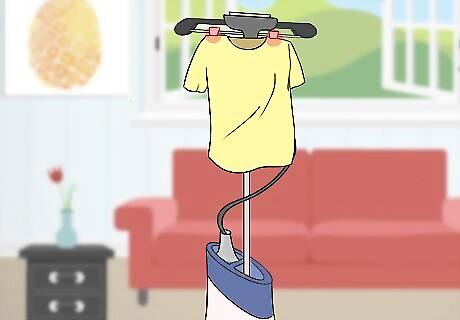
Hang the shirt up on a hook. If you’re using a standing steamer, hook the clothes hanger onto the built-in stand. If you don’t have a stand, you can suspend the hanger from an over-the-door hook, a rolling garment rack, or a shower curtain ring. The goal is to keep the shirt upright and off of the floor. Note that the steam may affect the surface behind it. Only hang your shirt against surfaces that can withstand high heat and moisture. For instance, if you don’t want to expose your wood door to moisture and heat, pick a different location like your glass shower door.

Fill the steamer with distilled or purified water up to the fill line. Tap water contains minerals that will clog up the steamer and get deposited onto your clothes. Instead, boil a pot of tap water and allow it to cool down before adding it to the steamer. You can also choose to fill your steamer with pre-bottled distilled water. Pour the water into the base of a standing steamer, or the water canister on a handheld steamer. Don’t fill the steamer beyond the fill line as you may cause an explosion of hot, steamy water. You can always add more water once you use up the supply.
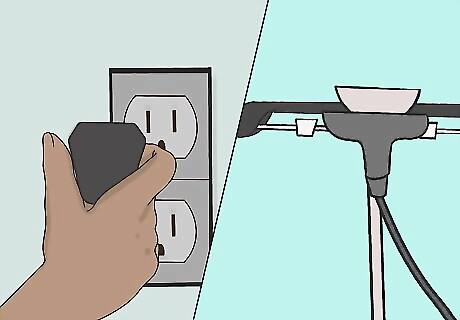
Plug in and turn on the steamer to heat it up completely. Some steamers will begin heating up immediately, but others will need to be turned on once plugged in. Make sure the steam head is upright when you turn it on, so that moisture doesn’t pour out. For a standing steamer, you can hook the steam head onto the garment stand while it heats up. If you’re using a handheld steamer, make sure it’s standing upright on its base. If you’re using a clasp attachment or a brush, clip on the steam head attachment prior to turning on the steamer. Allow the steamer to heat up completely before using it. Wait until you see steam emerging from the steamer. Or, if the steamer has a trigger, you might watch for a light that indicates when it’s ready to use.
Steaming the Placket, Collar, and Cuffs
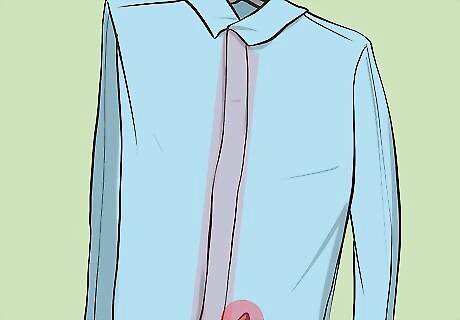
Hold the base of the button placket and pull the fabric taut. For the best results, you’ll start with the stiff, structural parts of the shirt. First will be the button placket (the left and right sides of the shirt where the buttons and corresponding buttonholes are located). With the mostly-unbuttoned shirt secured on the hanger, tug on the bottom or hem of one side of the placket to pull it taut.

Place the steam head on the inside of the button placket. With the steam holes facing towards you, bring the steam head into contact with the fabric on one side of the placket. Continue holding the bottom of the placket taut. If you’re using a clasp attachment, use it to grip the placket flat against the steam head.
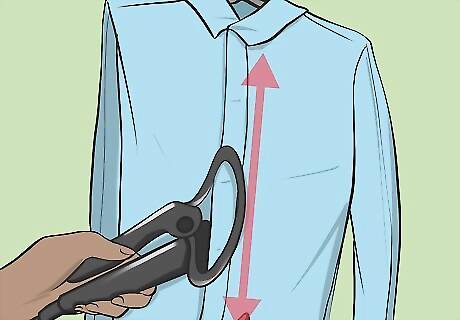
Run the steamer along the inside of the placket in up and down strokes. While still holding the placket taut and pressing the steam head gently against the inside of the fabric, engage the trigger so that the steam comes out (if your steamer has this type of control). Move the steam head slowly up and down along the full length of the placket until the creases relax. Depending on the fabric and how wrinkled it is, you’ll probably need to run the steamer up and down each part of the garment about 2 to 8 times to completely smooth out the fabric. Repeat this process for the other side of the placket.
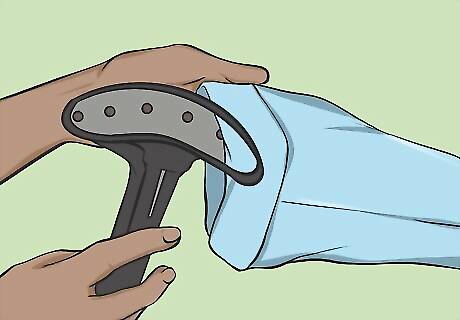
Unbutton the cuffs and hold them open vertically to steam. Since the steam moves directly upwards, you’ll want to position the cuffs vertically so they catch as much steam as possible. Undo the cuff buttons and flatten out the cuffs. Hold each one vertically from the top. Drag the steam head up and down over the cuffs from the front and back until the fabric smooths out.

Hold the shirt by one of the collar points to steam the collar. Take the shirt off of the hanger for this step. Flatten out the collar and pinch one of the collar points. Hold up the shirt in this way, letting gravity keep the shirt collar vertical. Then, as you did for the button placket and cuffs, run the steamer up and down the collar fabric in a few passes to de-wrinkle it.
Removing Creases from the Shirt Body and Sleeves
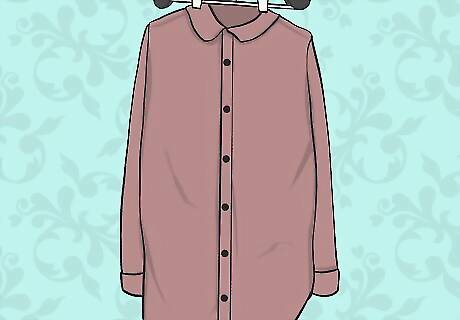
Button up the shirt completely on the hanger. Once you’ve steamed out the stiffer elements, you can move onto the body of the shirt. Place the shirt back on the hanger and do up all of the buttons. Hang it back onto the hook with the front of the shirt facing you.

Slip the steamer head inside the garment with the steam holes facing you. With the steamer inside, gravity will keep your shirt in place and the steamer will stay in contact with the fabric as you move the steamer. Bring the steam head in contact with the inside of the front of the shirt, since you’ll be smoothing out the front first. If you’re steaming from the outside, sometimes the force of the steam will push the garment away, even if you’re trying to hold it taut. This is a trick used by professionals to quickly and effectively steam clothes.
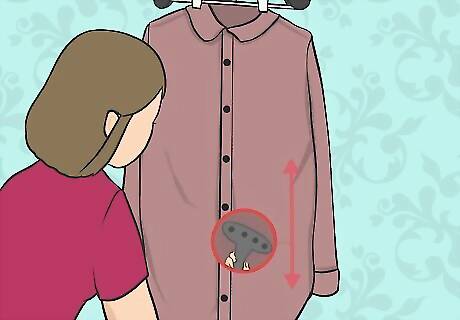
Drag the steamer head up and down along the inside of the shirt. With the steam head in contact with the fabric, slowly but firmly move the steamer up and down in vertical passes on the inside of the shirt panels. Hold the hem of the shirt to keep the fabric taut and reposition your hand as you work across the width of the shirt. Engage the trigger to release the steam if your handheld steamer has one. You can go back over certain parts if you didn’t get all the creases out in the first few passes. It could take around 2 to 8 passes for the fabric to relax. Even if you’re trying to steam out a certain spot on the shirt, keep the steam head moving above and below that spot so that the steam can penetrate the fabric.

Flip the garment around on the hook to steam the back of the shirt. You’ll follow the same process as you did when steaming the front of the shirt. Slip the steam head back into the shirt with the holes facing you and pressing gently against the back of the shirt. Then draw it along the fabric in vertical motions, gradually working from one side to the other. To smooth out the yoke (the top panel going across the back of the shirt), try steaming first from the inside. If there are still some wrinkles remaining, guide the steam head along the outside of the yoke in short up and down motions, passing across the full width of the yoke to release creases from the seamed areas.
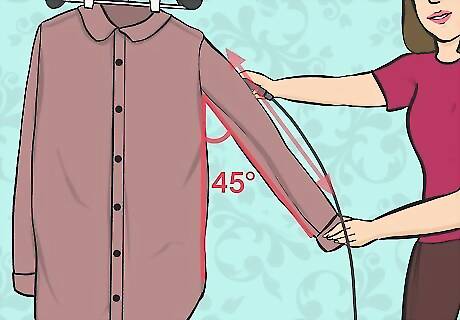
Hold each of the sleeves out taut to steam them from the outside. Grasp the sleeve from the cuff to prevent it from moving around as you steam it. First draw the steamer slowly up and down along the back side of the sleeve, with the steam holes touching the fabric and facing towards you. Then bring the steamer to the front with the holes facing away from you as you work along the front side of the sleeve. Hold the sleeve at a 45-degree downward angle rather than straight out. Make sure there’s no wrinkling in the armhole area since you could risk setting these creases into the sleeve.
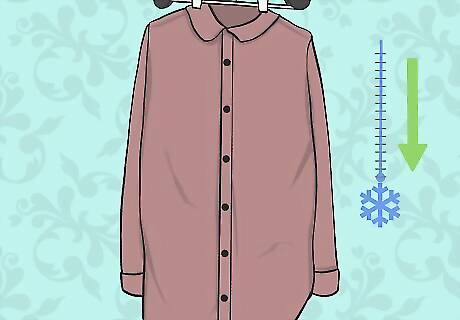
Let the shirt cool off and dry completely on the hanger. Before throwing on your shirt or returning it to the closet, allow it to cool and dry for at least 5 minutes. Make sure it feels cool and dry to the touch. If there’s any moisture or heat remaining when you wear or store it, you could risk setting wrinkles into the fabric.
Selecting a Garment Steamer

Choose a handheld steamer for occasional home use. Some handheld steamers have a handle like a kettle, and others are held at the center. Many come with a trigger so you can control the release of steam. A decent one will cost between 30 to 60 USD. Like an everyday iron, a handheld garment steamer can be tucked neatly away when it’s not in use. Look for one with an extra-long power cord (or a cordless steamer) so you can easily use it around the house. The downside is that handheld steamers can be pretty bulky and heavy, especially when they’re filled up with water. You might wear your arm out if you’re steaming a lot of shirts in a row.
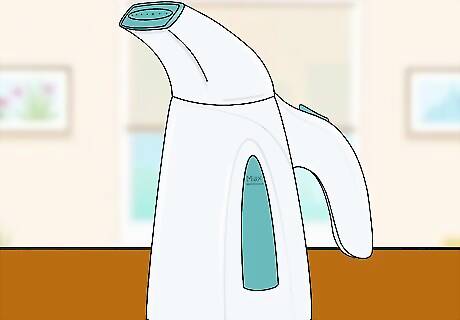
Select a portable handheld steamer for steaming clothes during your travels. Portable steamers are smaller and don’t come with many bells and whistles, as larger handheld steamers, but they help you get the job done while you’re on the go. Look for one that heats up quickly and holds enough water to completely steam a single shirt. An extra-long cord would be advantageous on a portable steamer. This way, you won’t worry too much about not being able to plug it next to where you’ve hung up the shirt in a hotel room.
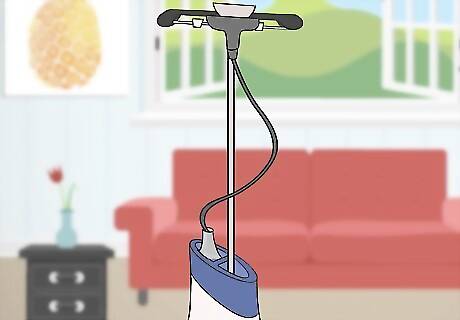
Opt for a standing garment steamer for high-volume steaming. If you’re doing a lot of steaming, a standing garment steamer is the most professional and convenient choice. A good one may cost 100 USD or more and will come with a rod and hook for hanging your clothes on. It will also have a lightweight, heavy-duty metal steam head. Unlike a handheld steamer, a standing steamer holds more water in a canister at the base. This means you don’t have to carry the weight of the water as you steam the garment. Standing steamers don’t typically have triggers for controlling the rate of steam. But that’s actually very useful for high-volume steaming since you don’t need to keep your finger down on the trigger while you work.
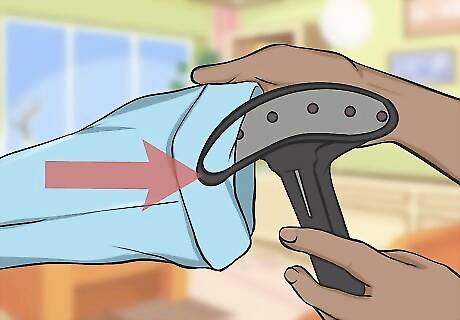
Consider getting a clasp attachment for crisper shirt steaming. If you’re using a standing steamer, try adding on a specialized clasp attachment that’s designed for use on dress shirts. This type of clasp can be used to hold parts of the shirt taut across the steamer, so you can smooth out the fabric quicker and with more precision. Like a big clothespin or chip clip, you can use the attachment to pinch the shirt between the clasp and the steam head. Handheld and standing steamers can come with a variety of steam head attachments, such as brushes that will help grip the fabric as you steam it.

















Comments
0 comment